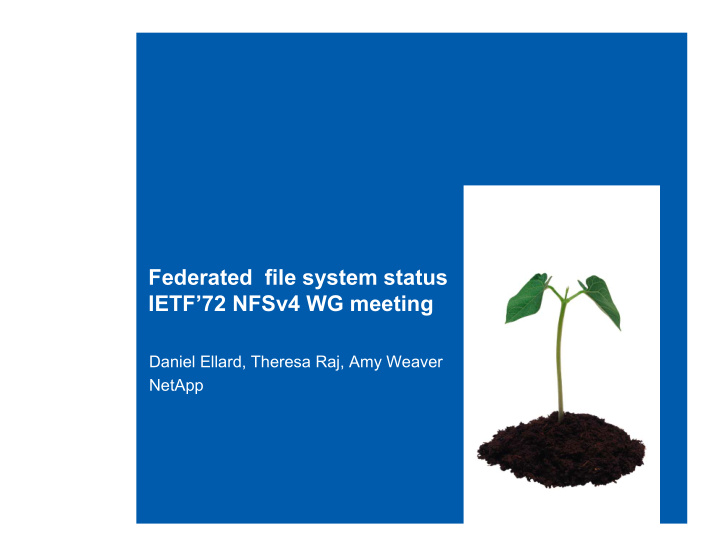



Tag line, tag line Federated file system status IETF’72 NFSv4 WG meeting Daniel Ellard, Theresa Raj, Amy Weaver NetApp
Acknowledgments Many people have contributed! Craig Everhart: NetApp ATG Renu Tewari, Manoj Naik: IBM/Almaden Paul Lemahieu, EMC/Rainfinity Mario Würzl: EMC Rob Thurlow: SUN 2
Outline Overview Current status 3
Goals An open, portable protocol that permits the construction of cross-platform, federated file systems accessible to unmodified NFSv4 clients. – Open and portable: anyone can use it – Cross-platform: cross-vendor, cross-system, cross-version – Federated: federation members don’t have to give up control of their systems Not meant to replace existing cluster protocols! – Cluster-of-clusters protocol 4
Project history 2/2007: Public “federated-fs” community formed at FAST’07 – Mailing list and weekly conference calls 6/2007: First draft of requirements doc – Includes common terms and definitions – Presented at IETF’69 12/2007: First draft of protocol specs – Presented at IETF’70 and IETF’71 6/2008: Proof-of-concept implementation 5
Terms and definitions Fileset: a directory tree (volume) Junction: a fileset object that provides a way for one fileset to reference the root of another FSL (fileset location): the location of a fileset instance FSN (fileset name): an opaque fileset identifier NSDB (namespace database): a service that tracks the mapping between FSNs and FSLs – Typically one NSDB per administrative domain Each FSN contains an FsnUuid (a UUID) and an NSDB location 6
Protocol overview NFSv4 servers know where the junctions are – Can detect when a client accesses a junction – Can figure out the FSN of the target fileset – How both of these are accomplished are implementation details – not part of the protocol NSDBs know where each FSN is implemented NFSv4 servers contact the NSDBs to find where to redirect clients when the client accesses a junction Administrators manage the junctions and the FSN->FSL mappings 7
Three sub-protocols are being proposed 1. Resolution (server to NSDB): where are the filesets? 2. NSDB administration (admin to NSDB): FSN->FSL map 3. Junction management (admin to server): create, delete, manage junctions Note: no changes to client protocols NSDB Resolution NSDB administration Cluster NFS Admin Server Junction management 8
Status Requirements draft fairly stable – Common terms and definitions agreed upon Three sub-protocol drafts in progress – Resolution protocol: farthest along – NSDB admin protocol: personal draft – Server admin protocol: straw man proposal 9
Open issues Much discussion over a possible fourth sub- protocol for root fileset discovery – May require changes to the client (bad) – May simplify configuration of the client (good) Current NSDB based on LDAP – LDAP is a convenient platform for a directory – LDAP might not be adequately extensible Cross-enterprise authentication/identity – How effectively can we federate identity without mutual trust? We could really use a fileset migration protocol 10
Conclusions We believe that this work is ready to be picked up by the NFSv4 WG and added to charter – Proposed on the nfsv4 mailing list – All responses were positive For more information, join the federated-fs mailing list: federated-fs@sdsc.edu 11
Recommend
More recommend